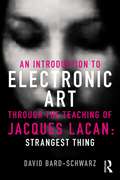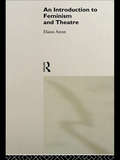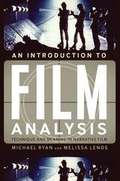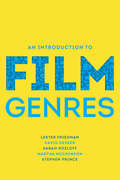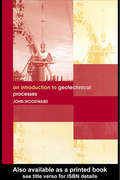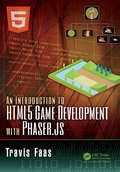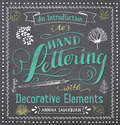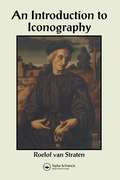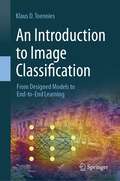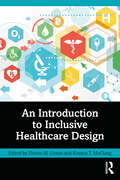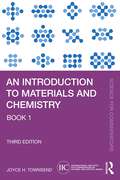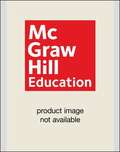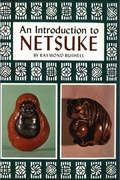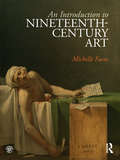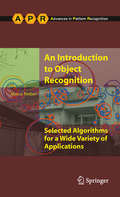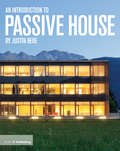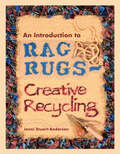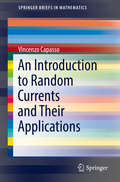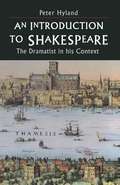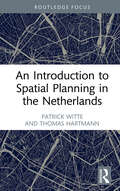- Table View
- List View
An Introduction to Electronic Art Through the Teaching of Jacques Lacan: Strangest Thing
by David Bard-SchwarzElectronic art offers endless opportunities for reflection and interpretation. Works can be interactive or entirely autonomous and the viewer's perception and reaction to them may be challenged by constantly transforming images. Whether the transformations are a product of the appearances or actions of a viewer in an installation space, or a product of a self-contained computer program, is a source of constant fascination. Some viewers may feel strange or unnerved by a work, while others may feel welcoming, humorous, and playful emotions. The art may also provoke a critical response to social, aesthetic, and political aspects of early twenty-first-century life. This book approaches electronic art through the teachings of Jacques Lacan, whose return to Freud has exerted a powerful and wide-ranging influence on psychoanalysis and critical theory in the twentieth century. David Bard-Schwarz draws on his experience with Lacanian psychoanalysis, music, and interactive and traditional arts in order to address aspects of the works the viewer may find difficult to understand. Dividing his approach over four thematic chapters—Bodies, Voices, Eyes, and Signifiers—Bard-Schwarz explores the links between works of new media and psychoanalysis (how we process what we see, hear, touch, imagine, and remember). This is a fascinating book for new media artists and critics, museum curators, psychologists, students in the fine arts, and those who are interested in digital technology and contemporary culture.
An Introduction to Feminism and Theatre
by Elaine AstonAt last an accessible and intelligent introduction to the energising and challenging relationship between feminism and theatre. In this clear and enlightening book, Aston discusses wide-ranging theoretical topics and provides case studies including: * Feminism and theatre history * `M/Othering the self': French feminist theory and theatre * Black women: shaping feminist theatre * Performing gender: a materialist practice * Colonial landscapes Feminist thought is changing the way theatre is taught and practised. An Introduction to Feminism and Theatre is compulsory reading for anyone who requires a precise, insightful and up-to-date guide to this dynamic field of study.
An Introduction to Film Analysis: Technique and Meaning in Narrative Film
by Michael Ryan Melissa LenosAn Introduction to Film Analysis combines an introduction to filmmaking technique with rigorous and comprehensive training in film interpretation. Composed in an accessible style yet conversant with the latest, most advanced critical theories and methods, this innovative textbook can be reliably used on both the undergraduate and the graduate level. The book begins with chapters that familiarize students with the basic components of film technique. It connects technique to meaning and demonstrates, through numerous examples, how particular uses of film technique generate different meanings. Students will learn how films are made and how values are promoted, ideas communicated, and rhetorical arguments advanced through film technique. The second part of the book covers a range of interpretive methods, theories, and concerns. In each section, the author offers a sample reading of a film, followed by an "interpretive exercise" with suggestions for students to use in performing their own film interpretation. Carefully structured, beautifully written, and illustrated throughout, An Introduction to Film Analysis provides a thorough grounding in the subject for students around the world.
An Introduction to Film Genres (First Edition)
by Sarah Kozloff Stephen Prince David Desser Lester Friedman Martha NochimsonA brisk, accessible, and informative introduction to film genres. An Introduction to Film Genres, written by leading film scholars specifically for undergraduates who are new to the study of film, provides an introduction that helps students see thirteen film genres in a new light---to help them identify the themes, iconography, and distinctive stylistic traits of each genre. This purchase offers access to the digital ebook only
An Introduction to Film and TV Production: From Concept to Market
by Karen Russell Tameka Winston Joseph Richie Airielle J. TaylorThis streamlined, step-by-step guide provides students and newcomers in the field of media with an overview of the complete production process, from conceiving of an idea to marketing the final product. Readers will learn what it takes to create a concept, develop it, and then market and sell it. Chapters discuss pitching, producing, marketing visionary concepts, financing, and distributing content. Focused on traditional and non-traditional platforms including social media, websites, and online advertising, this book explores currently evolving media platforms, ideas, and practices and provides examples of how to navigate these unique creative processes. Interviews with business executives offer insider tips and tricks to creating a marketable project. In this book, you will learn how to: Distinguish between a "great idea" and a "marketable idea." Condense your concept into an effective "elevator pitch." Build a basic business plan. Create a marketing strategy, be it traditional, digital, or both. Establish a personal brand and portfolio that will grab the right attention. This book will be of great help to the student, independent filmmaker, and content creator looking to understand the process of getting their work produced, distributed, and marketed.
An Introduction to Geotechnical Processes
by John WoodwardThe study of the solid part of the earth on which structures are built is an essential part of the training of a civil engineer. Geotechnical processes such as drilling, pumping and injection techniques enhance the viability of many construction processes by improving ground conditions.Highlighting the ground investigation necessary for the process
An Introduction to HTML5 Game Development with Phaser.js
by Travis FaasExperience the thrill of crafting your own HTML5 game with Phaser.js game engine. HTML5 and modern JavaScript game engines have helped revolutionized web based games. Each chapter in An Introduction to HTML5 Game Development with Phaser.js showcases a sample game that illustrates an aspect of Phaser.js (now Lazer.js) that can be used as is, or in remixed games of the developer’s design. Each of these examples help the reader to understand how to optimize JavaScript game development with modern project tooling like Grunt and Bower. Though the world of HTML game development continues to grow and evolve, An Introduction to HTML5 Game Development with Phaser.js, provides a grounded resource and vital learning tool to anyone looking to optimize web game development process. Key Features Chapter objectives and examples with sample code make concepts easy to grasp Master questions and chapter summaries further help to solidify these concepts Feature boxes that contain important hints and things to note help keep readers on the right path This book uses a "building blocks" approach to game development and starts with the technology required to get things running Each chapter will be a small sample game that demonstrates one piece of Phaser.js, giving the reader time to grasp and understand the core concepts Subsequent chapters will demonstrate new features, building upon the knowledge of previous examples
An Introduction to Hand Lettering with Decorative Elements (Lettering, Calligraphy, Typography)
by Annika SauerbornA treasure trove of lettering styles and decorative elements, this handy reference offers an abundance of eye-catching alphabets, numerals, ribbons, borders, flowers, banners, and other easy-to-trace embellishments. With this guide, it's easy to add a personal touch—humorous, dramatic, or romantic—to any handwritten message or meditative journal.Hundreds of ornaments, all of them hand-drawn by the author, include dozens of alphabets and numerals. You'll also find frames, flourishes, and corner designs that provide pages with a stylish finishing touch. Decorative motifs range from arrows, hearts, and stars to leaves, blossoms, and wreaths. A wealth of fanciful graphics for special occasions includes designs for birthdays, weddings, holidays, and all four seasons. Calligraphers, crafters, and illustrators as well as anyone who wants to add a bit of pizzazz to their writing will prize this imaginative source of inspiration.
An Introduction to Iconography: Symbols, Allusions and Meaning in the Visual Arts (Documenting The Image Ser. #Vol. 1)
by Roelof van StratenAvailable for the first time in English, An Introduction to Iconography explains the ways that artists use references and allusions to create meaning. The book presents the historical, theoretical, and practical aspects of iconography and ICONCLASS, the comprehensive iconographical indexing system developed by Henri van de Waal. It gives particular emphasis to the history of iconography, personification, allegory, and symbols, and the literary sources that inform iconographic readings, and includes annotated bibliographies of books and journal articles from around the world that are associated with iconographic research.The author of numerous articles and a four-volume reference work on Italian prints, Roelof van Straten is currently working on an iconographic index covering the prints of Goltzius and his school.
An Introduction to Image Classification: From Designed Models to End-to-End Learning
by Klaus D. ToenniesImage classification is a critical component in computer vision tasks and has numerous applications. Traditional methods for image classification involve feature extraction and classification in feature space. Current state-of-the-art methods utilize end-to-end learning with deep neural networks, where feature extraction and classification are integrated into the model. Understanding traditional image classification is important because many of its design concepts directly correspond to components of a neural network. This knowledge can help demystify the behavior of these networks, which may seem opaque at first sight. The book starts from introducing methods for model-driven feature extraction and classification, including basic computer vision techniques for extracting high-level semantics from images. A brief overview of probabilistic classification with generative and discriminative classifiers is then provided. Next, neural networks are presented as a means to learn a classification model directly from labeled sample images, with individual components of the network discussed. The relationships between network components and those of a traditional designed model are explored, and different concepts for regularizing model training are explained. Finally, various methods for analyzing what a network has learned are covered in the closing section of the book. The topic of image classification is presented as a thoroughly curated sequence of steps that gradually increase understanding of the working of a fully trainable classifier. Practical exercises in Python/Keras/Tensorflow have been designed to allow for experimental exploration of these concepts. In each chapter, suitable functions from Python modules are briefly introduced to provide students with the necessary tools to conduct these experiments.
An Introduction to Inclusive Healthcare Design
by Denise M. Linton Kiwana T. McClungAn Introduction to Inclusive Healthcare Design is a comprehensive guide to the design and facilitation of safe, healthy, equitable, and inclusive healthcare settings across a variety of scales. The book informs healthcare professionals, healthcare administrators, planners, designers in the healthcare sector, design students, and faculty about best practices and considerations for inclusive design.The primary theme for the book is design for all – considering the design of healthcare spaces through the lenses of inclusivity and social equity. Part 1 presents the reader with an overview of the variety of locations and types of healthcare settings. Part 2 provides a comprehensive overview of the principles of equitable and inclusive healthcare design and considers how these principles can be applied to the range of settings laid out in Part 1. The authors consider inclusivity-supportive infrastructure in primary and ancillary spaces within healthcare settings. Part 3 envisions the future of inclusive healthcare design, considering the integration of virtual reality and artificial intelligence, as well as addressing the ever more relevant issue of healthcare provision in settings at risk of natural disasters.
An Introduction to Information Design
by Kathryn Coates Andy EllisonInformation design is the visualization of information through graphic design. This invaluable guide provides a creative, informative, and practical introduction to the general principles of information design. With chapters on understanding the audience, structure, legibility and readability, selection of media, experimentation, and multi-platform delivery, An Introduction to Information Design gives a complete overview of this fundamental aspect of visual communication. Fully illustrated case studies from leading designers provide professional insight into the challenges involved in creating information design for print, interactive, and environmental media. Practical exercises and tips enable the reader to put this learning into practice. This makes it the perfect book for graphic design students as well as design enthusiasts.
An Introduction to Information Design
by Kathryn CoatesInformation design is the visualization of information through graphic design. This invaluable guide provides a creative, informative, and practical introduction to the general principles of information design. With chapters on understanding the audience, structure, legibility and readability, selection of media, experimentation, and multi-platform delivery, An Introduction to Information Design gives a complete overview of this fundamental aspect of visual communication. Fully illustrated case studies from leading designers provide professional insight into the challenges involved in creating information design for print, interactive, and environmental media. Practical exercises and tips enable the reader to put this learning into practice. This makes it the perfect book for graphic design students as well as design enthusiasts.
An Introduction to Japanese Kanji Calligraphy
by Bob Godin Takezaki KuniiThis step-by-step Japanese calligraphy book explains the systems of Japanese language and delves into details of written Japanese characters and techniques of kanji calligraphy.The word calligraphy literally means "beautiful writing." It is an art form that can be found in most civilizations with a written script. Originally developed to stress the importance of culture, religion and philosophy, over time calligraphy in most languages has developed into a purely artistic expression.In Japanese culture, kanji characters from the Japanese writing system are used in calligraphy. An Introduction to Japanese Kanji Calligraphy is an exploration of this Asian art form, and examines how calligraphic poetry developed in Japan. Written by a Japanese shodo master, it is a wonderful introduction to the beautiful art of Japanese calligraphy.Japanese Kanji Calligraphy includes:An introduction to Japanese calligraphy Background information on the modern Japanese language Hiragana and katakana charts An explanation of the tools of calligraphy A guide to correct calligraphy techniques Step-by-step calligraphy instructions An extensive kanji character library
An Introduction to Literature and the Fine Arts
by The Editors at Michigan State College PressA collaborative study of the arts of literature, music, sculpture, architecture, and painting in the development of the Western tradition.
An Introduction to Materials and Chemistry: Book 1 (Science for Conservators)
by Joyce H. TownsendThis new edition of An Introduction to Materials and Chemistry, book 1 in the updated Science for Conservators series, provides conservators and conservators-in-training with a very basic introduction to the language of chemistry and to the scientific approach. Drawing on 40 years of experience as a conservation scientist, Joyce H. Townsend takes readers through the elementary steps that will enable them to understand and investigate materials in historic objects, and those modern materials used to conserve them, in scientific terms. The book also introduces basic chemistry concepts. It provides worked examples and exercises throughout. This new edition has been significantly expanded and updated, with new material about health and safety, sustainability, and the trend to use greener materials, amongst other topics. The book also includes all-new illustrations, a list of further reading and is accompanied by a Companion Website, which features additional examples, illustrations and more. An Introduction to Materials and Chemistry assumes no previous scientific knowledge and will be essential reading for pre-program applicants to, and students already on, postgraduate conservation programs worldwide. It will also be useful to conservators who are looking to refresh their knowledge or to fill gaps in their training, and for those who trained in languages other than English, but now work in that language.
An Introduction to Music and Art in the Western World (10th edition)
by Milo Wold Edmund Cykler Gary Martin James MillerAn undergraduate introduction to the music, painting, sculpture, and architecture of the Western world, featuring chapter objectives and summaries, pronunciation guides, and chronologies. Covers various periods from the ancient Greeks through the arts today, and includes material on the arts and society and the organization of the elements of art and music. This 10th edition contains increased recognition of women and minority artists, and boxes on selected individual works. Annotation c. by Book News, Inc., Portland, Or.
An Introduction to Netsuke
by Raymond BushellWith dozens of photos and illustrations, A Introduction to Netsuke is a readable and thorough guide to Japanese miniature art.Among the many Japanese fine arts, few have aroused greater admiration than the netsuke. This miniature piece of Japanese sculpture, approximately 1 1/2 inches in size, was designed (in the absence of pockets on kimonos) as an aid in suspending articles such as tobacco pouches from the sash of a kimono. It developed in ancient times as a utilitarian object, but became in the 16th century an artistic one as well, and flourished as such until 1926. No longer commonly worn, the netsuke is now a collectors' item, avidly sought throughout the world by those sensitive to its fine qualities.This book opens the miniature world of netsuke to those who have hitherto been unaware of its existence. In a delightfully lucid manner, the basics of the netsuke are presented-definition, origin, development, materials, statistics, and photographs. This book admirably fulfills its task of introducing the netsuke to the layman, irresistibly drawing him to new pleasures in aestheticism and culture.
An Introduction to Nineteenth-Century Art
by Michelle FacosUsing the tools of the "new" art history (feminism, Marxism, social context, etc.) An Introduction to Nineteenth-Century Art offers a richly textured, yet clear and logical, introduction to nineteenth-century art and culture. This textbook will provide readers with a basic historical framework of the period and the critical tools for interpreting and situating new and unfamiliar works of art. Michelle Facos goes beyond existing histories of nineteenth-century art, which often focus solely on France, Britain, and the United States, to incorporate artists and artworks from Scandinavia, Germany, and Eastern Europe. The book expertly balances its coverage of trends and individual artworks: where the salient trends are clear, trend-setting works are highlighted, and the complexity of the period is respected by situating all works in their proper social and historical context. In this way, the student reader achieves a more nuanced understanding of the way in which the story of nineteenth-century art is the story of the ways in which artists and society grappled with the problem of modernity. Key pedagogical features include: Data boxes provide statistics, timelines, charts, and historical information about the period to further situate artworks. Text boxes highlight extracts from original sources, citing the ideas of artists and their contemporaries, including historians, philosophers, critics, and theorists, to place artists and works in the broader context of aesthetic, cultural, intellectual, social, and political conditions in which artists were working. Beautifully illustrated with over 250 color images. Margin notes and glossary definitions. Online resources at www.routledge.com/textbooks/facos with access to a wealth of information, including original documents pertaining to artworks discussed in the textbook, contemporary criticism, timelines and maps to enrich your understanding of the period and allow for further comparison and exploration. Chapters take a thematic approach combined within an overarching chronology and more detailed discussions of individual works are always put in the context of the broader social picture, thus providing students with a sense of art history as a controversial and alive arena of study. Michelle Facos teaches art history at Indiana University, Bloomington. Her research explores the changing relationship between artists and society since the Enlightenment and issues of identity. Prior publications include Nationalism and the Nordic Imagination: Swedish Painting of the 1890s (1998), Art, Culture and National Identity in Fin-de-Siècle Europe, co-edited with Sharon Hirsh (2003), and Symbolist Art in Context (2009).
An Introduction to Object Recognition: Selected Algorithms for a Wide Variety of Applications (Advances in Computer Vision and Pattern Recognition)
by Marco Alexander TreiberRapid development of computer hardware has enabled usage of automatic object recognition in an increasing number of applications, ranging from industrial image processing to medical applications, as well as tasks triggered by the widespread use of the internet. Each area of application has its specific requirements, and consequently these cannot all be tackled appropriately by a single, general-purpose algorithm. This easy-to-read text/reference provides a comprehensive introduction to the field of object recognition (OR). The book presents an overview of the diverse applications for OR and highlights important algorithm classes, presenting representative example algorithms for each class. The presentation of each algorithm describes the basic algorithm flow in detail, complete with graphical illustrations. Pseudocode implementations are also included for many of the methods, and definitions are supplied for terms which may be unfamiliar to the novice reader. Supporting a clear and intuitive tutorial style, the usage of mathematics is kept to a minimum. Topics and features: presents example algorithms covering global approaches, transformation-search-based methods, geometrical model driven methods, 3D object recognition schemes, flexible contour fitting algorithms, and descriptor-based methods; explores each method in its entirety, rather than focusing on individual steps in isolation, with a detailed description of the flow of each algorithm, including graphical illustrations; explains the important concepts at length in a simple-to-understand style, with a minimum usage of mathematics; discusses a broad spectrum of applications, including some examples from commercial products; contains appendices discussing topics related to OR and widely used in the algorithms, (but not at the core of the methods described in the chapters). Practitioners of industrial image processing will find this simple introduction and overview to OR a valuable reference, as will graduate students in computer vision courses. Marco Treiber is a software developer at Siemens Electronics Assembly Systems, Munich, Germany, where he is Technical Lead in Image Processing for the Vision System of SiPlace placement machines, used in SMT assembly.
An Introduction to Passive House
by Justin BereThroughout the world, Passive House is now recognised as the best method to create comfortable, healthy, low energy buildings and it is a key component of the 21st century's green economic revolution. Written by one of the UK's leading passive house architects, this book contains essays that reveal the technical and creative secrets of Passive House design, as well as containing case studies of some of the world's best examples of beautiful, technically excellent buildings that still feel great even when the power supply is turned down to almost nothing. Whether you are an architect, client, student or construction professional, this book is an enlightening introduction to Passive House and a valuable source of inspiration.
An Introduction to Rag Rugs - Creative Recycling: Creative Recycling (Crafts Ser.)
by Jenni Stuart-AndersonMaking is good for you. Exploring crafts can be relaxing and therapeutic : the projects in this book are accessible to anyone who is inspired to recycle old clothes and textiles into unique, decorative, useful projects. Our forbears improvised tools to recycle their worn clothes - mostly dark suiting or mill waste if they lived near a mill. Usually they made mats for their cold floors or as draft excluders across doors. Nowadays you can choose from so many more colors and textures - painting with rags! Try one project or more. You will be able to use the techniques to design and make your own one-off items for your home or as hand-made gifts. The techniques here are traditional and simple - you will be surprised at how drab fabrics become transformed. Simple designs work best and you can even improvise as you work. If a fabric runs out, then use another - I call that organic design! Hooking is the best technique for pictorial detail and different techniques could be combined for original wall art. Historically, rugs were made by several people sitting round a horizontal frame with the children cutting the pieces of rag which were prodded into the hessian (burlap) backing to make a shaggy mat. There is a prodded project (for purists) but you can also achieve the same effect without a frame by progging, which can be done on table or thigh (carefully). Warning – this craft can be addictive!
An Introduction to Random Currents and Their Applications (SpringerBriefs in Mathematics)
by Vincenzo CapassoThis book introduces random currents by presenting underlying mathematical methods necessary for applications. The theory of currents is an advanced topic in geometric measure theory that extends distribution to linear functionals within the space of differential forms of any order. Methods to extend random distributions to random currents are introduced and analyzed in this book. Beginning with an overview of mathematical aspects of the theory of currents, this book moves on to examine applications in medicine, material science, and image analysis. Applied researchers will find the practical modern mathematical methods along with the detailed appendix useful to stimulate new applications and research.
An Introduction to Shakespeare
by Peter HylandPeter Hyland provides a highly readable account of the historical, social and political pressures of Shakespeare's England and the material conditions under which his plays were written, including a comprehensive description of the development and status of the theatrical profession. Half of the book is given over to a survey of the plays and examines numerous controversial issues that arise when we ask precisely what we can 'know' about them. For those who are daunted by the volume or the impenetrable prose of much recent writing on Shakespeare, Hyland's book will be a stimulating introduction.
An Introduction to Spatial Planning in the Netherlands
by Thomas Hartmann Patrick WitteThis book provides an introduction to spatial planning in the Netherlands. It explores the academic underpinnings of the discipline and its practical implications, making use of insights on planning practices from the Netherlands. As an academic book with relevance for spatial planning teaching and practice, the relation between planning practice and planning as an academic discipline are discussed. A key analytical concept is introduced to discuss the different dimensions of planning: the planning triangle. This framework helps to bridging the strategic and conceptual elements of planning with its realization. The object, process and context of planning and its relations are discussed. The core of the academic discipline and profession of spatial planning entails looking (far) into the future, stimulating discussion, formulating a desired future direction through an informal and collective planning process and then formalizing and placing current action into that future perspective. In that sense, spatial planning can be understood as the strategic organisation of hopes and expectations. As a study book it is suitable for students of planning at various universities, but also for students in higher professional education. For those involved in the professional field of spatial planning, this book offers a sound foundation.
